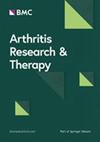在银屑病关节炎中,脑岛是一个关键的神经生物学疼痛中枢
IF 4.9
2区 医学
Q1 Medicine
引用次数: 0
摘要
疼痛仍然是银屑病关节炎(PsA)患者的主要主诉,尽管成功减轻了炎症。这种情况暗示了不同疼痛机制的共存。在临床上很难区分伤害性和伤害性机制。脑功能磁共振成像(fMRI)的进步已经成功地表征了几种疾病中不同的疼痛机制,特别是涉及脑岛。这是第一个利用功能磁共振成像表征PsA疼痛机制的神经生物学标志物的研究。PsA参与者进行了6分钟的静息状态fMRI脑部扫描,并使用数字评定量表(NRS, 0-100)对伤害性疼痛(2011年ACR纤维肌痛标准)和身体疼痛进行了问卷评估。脑岛种子(前、中、后)和整个大脑之间的功能连通性与上述疼痛结果(校正了年龄和性别)以及多重比较的错误发现率(FDR)相关。共纳入46例受试者(年龄49±11.2;52%的女性;FM评分12.5±5.7分;总疼痛34.8±23.5)。纤维肌痛评分较高的PsA参与者显示:(1)右岛前部到DMN (P < 0.05),(2)右岛中部和左岛后部到海马旁回(P < 0.01 FDR)之间的连接增加;(3)右岛中部至左额极(P = 0.001 FDR)。整体疼痛与左脑岛后部与经典伤害感觉区域的连通性相关,包括丘脑(P = 0.01 FDR)和脑干(P = 0.002 FDR)。我们首次客观地证明了PsA中伤害性和伤害性疼痛机制共存。不能假设PsA疼痛的起源仅仅是伤害性的,未来对伤害性疼痛的筛查将为补充镇痛方法提供信息。本文章由计算机程序翻译,如有差异,请以英文原文为准。
The insula represents a key neurobiological pain hub in psoriatic arthritis
Pain remains a principal complaint for people with psoriatic arthritis (PsA), despite successful mitigation of inflammation. This situation alludes to the co-existence of distinct pain mechanisms. Nociceptive and nociplastic mechanisms are clinically challenging to distinguish. Advances in brain functional magnetic resonance imaging (fMRI) have successfully characterised distinct pain mechanisms across several disorders, in particular implicating the insula. This is the first study to characterise neurobiological markers of pain mechanisms in PsA employing fMRI. PsA participants underwent a 6-minutes resting-state fMRI brain scan, and questionnaire assessments of nociplastic pain (2011 ACR fibromyalgia criteria) and body pain, assessed using the Numeric Rating Scale (NRS, 0-100). Functional connectivity between insula seeds (anterior, mid, posterior), and the whole brain was correlated with the above pain outcomes correcting for age and sex, and false discovery rate (FDR) for multiple comparisons. A total of 46 participants were included (age 49 ± 11.2; 52% female; FM score 12.5 ± 5.7; overall pain 34.8 ± 23.5). PsA participants with higher fibromyalgia scores displayed increased connectivity between: (1) right anterior insula to DMN (P < 0.05), (2) right mid and left posterior insula to parahippocampal gyri (P < 0.01 FDR); and (3) right mid insula to left frontal pole (P = 0.001 FDR). Overall pain was correlated with connectivity of left posterior insula to classical nociceptive regions, including thalamus (P = 0.01 FDR) and brainstem (P = 0.002 FDR). For the first time, we demonstrate objectively that nociceptive and nociplastic pain mechanisms co-exist in PsA. PsA pain cannot be assumed to be only nociceptive in origin and screening for nociplastic pain in the future will inform supplementary analgesic approaches.
求助全文
通过发布文献求助,成功后即可免费获取论文全文。
去求助
来源期刊

Arthritis Research & Therapy
RHEUMATOLOGY-
CiteScore
8.60
自引率
2.00%
发文量
261
审稿时长
14 weeks
期刊介绍:
Established in 1999, Arthritis Research and Therapy is an international, open access, peer-reviewed journal, publishing original articles in the area of musculoskeletal research and therapy as well as, reviews, commentaries and reports. A major focus of the journal is on the immunologic processes leading to inflammation, damage and repair as they relate to autoimmune rheumatic and musculoskeletal conditions, and which inform the translation of this knowledge into advances in clinical care. Original basic, translational and clinical research is considered for publication along with results of early and late phase therapeutic trials, especially as they pertain to the underpinning science that informs clinical observations in interventional studies.
 求助内容:
求助内容: 应助结果提醒方式:
应助结果提醒方式:


